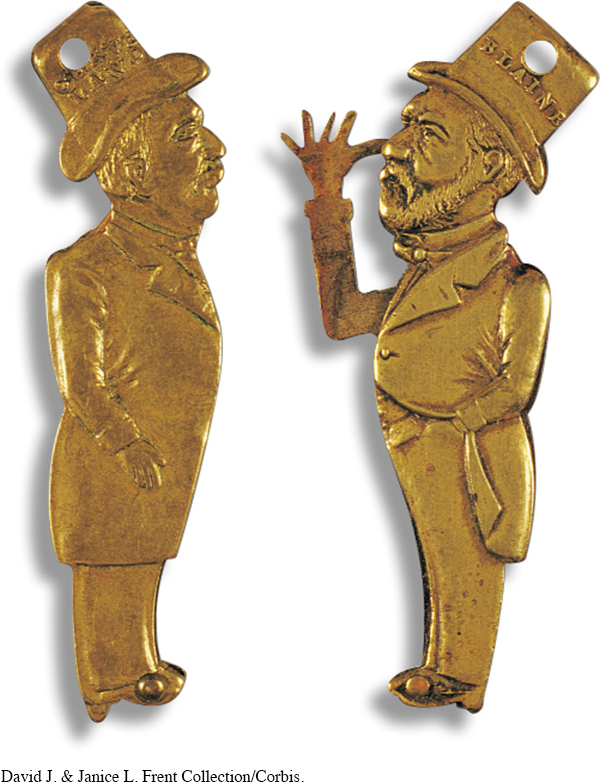The American Promise: Printed Page 497
The American Promise, Value Edition: Printed Page 456
The American Promise: A Concise History: Printed Page 518
Introduction to Chapter 18
The American Promise: Printed Page 497
The American Promise, Value Edition: Printed Page 456
The American Promise: A Concise History: Printed Page 518
Page 49718
Railroads, Business, and Politics in the Gilded Age
1865–

CONTENT LEARNING OBJECTIVES
After reading and studying this chapter, you should be able to:
Describe the ways in which industries were transformed in the late nineteenth century, including the railroad, steel, and oil industries.
Explain the factors that led to business mergers and the rise of corporations and explain the role of finance capitalism. Describe the ideas of social Darwinism and the gospel of wealth.
Describe how regional sectionalism, race, and gender affected political culture in the late nineteenth century.
Describe the issues and personalities that drove national party politics during the Gilded Age and explain why the Republican Party divided into factions.
Identify the key economic issues of the Gilded Age and how those issues led to party realignment in the 1890s.
ONE NIGHT OVER DINNER, MARK TWAIN AND CHARLES Dudley Warner teased their wives about the sentimental novels they read. When the two women challenged them to write something better, they set to work. Warner supplied the melodrama while Twain “hurled in the facts.” The result, The Gilded Age (1873), was a runaway best seller, a savage satire of the “get-
Twain left no one unscathed in the novel—
Why the matter is simple enough. A Congressional appropriation costs money. . . . A majority of the House Committee, say $10,000 apiece—
The American Promise: Printed Page 497
The American Promise, Value Edition: Printed Page 456
The American Promise: A Concise History: Printed Page 518
Page 498The Gilded Age seemed to tarnish many who lived under its reign. No one knew that better than Twain, who, even as he attacked it as an “era of incredible rottenness,” fell prey to its enticements. Born Samuel Langhorne Clemens, he grew up in a rough Mississippi River town, where he became a riverboat pilot. Taking the pen name Mark Twain, he wrote and played to packed houses as an itinerant humorist. But his work was judged too vulgar for the genteel tastes of the time. Boston banned his masterpiece, The Adventures of Huckleberry Finn, when it appeared in 1884. Huck Finn’s creator eventually stormed the citadels of polite society and hobnobbed with the wealthy. Succumbing to the money fever of his age, he plunged into a scheme in the hope of making millions. By the 1890s, he faced bankruptcy. Twain’s tale was common in an age when the promise of wealth led as many to ruin as to riches. Wall Street panics in both 1873 and 1893 plunged the country into depression.
The rush to build railroads and other industries and the corrupt interplay of business and politics formed the key themes in the Gilded Age. The runaway growth of the railroads and the surge in new inventions and technologies like electricity, the telephone, and the telegraph encouraged the rise of big business and led to an age of industrial capitalism.
Such rapid growth had alarming social and political implications. Economic issues increasingly shaped party politics. Social Darwinism, with its insistence on the “survival of the fittest,” supported the power of the wealthy, while the poor and middle classes championed antimonopoly measures to restore competition, currency reform to ease debt, and civil service to end corruption. As always, race, class, and gender influenced politics and policy.
The hopes and fears of the Gilded Age were most evident in the public’s attitude toward the business moguls of the day. Men like Jay Gould, Andrew Carnegie, and John D. Rockefeller sparked the popular imagination as the heroes and villains of industrialization. And as concern grew over the power of big business and the growing chasm between rich and poor, many Americans, women as well as men, looked to the government for solutions.
CHRONOLOGY
| 1869 |
|
| 1870 |
|
| 1872 |
|
| 1873 |
|
| 1874 |
|
| 1876 |
|
| 1877 |
|
| 1880 |
|
| 1881 |
|
| 1882 |
|
| 1883 |
|
| 1884 |
|
| 1886 |
|
| 1887 |
|
| 1888 |
|
| 1890 |
|
| 1892 |
|
| 1893 |
|
| 1895 |
|
| 1901 |
|